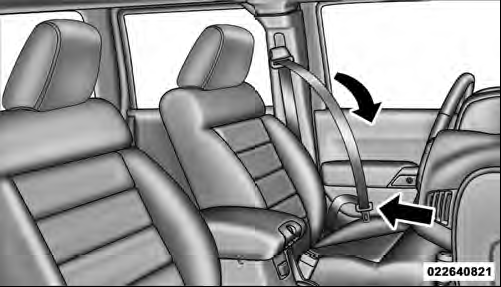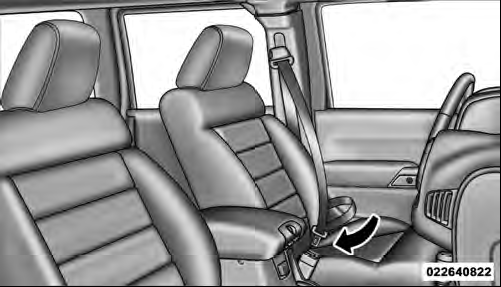Lap/Shoulder Belt Operating Instructions
1. Enter the vehicle and close the door. Sit back and adjust the seat.
2. The seat belt latch plate is above the back of the front seat and next to your arm in the rear seat. Grasp the latch plate and pull out the belt. Slide the latch plate up the webbing as far as necessary to allow the belt to go around your lap.

Pulling Out The Lap/Shoulder Belt Latch Plate
3. When the belt is long enough to fit, insert the latch plate into the buckle until you hear a “click.”

Inserting Latch Plate Into Buckle
WARNING!
• A belt that is buckled into the wrong buckle will not protect you properly. The
lap portion could ride too high on your body, possibly causing internal injuries.
Always buckle your belt into the buckle nearest you.
• A belt that is loose will not protect you properly. In a sudden stop you could move too far forward, increasing the possibility of injury. Wear your seat belt snugly.
• A belt that is worn under your arm is dangerous.
Your body could strike the inside surfaces of the vehicle in an accident, increasing head and neck injury. A belt worn under the arm can cause internal injuries. Ribs aren’t as strong as shoulder bones.Wear the belt over your shoulder so that the strongest bones will take the force in a collision.
• A shoulder belt placed behind you will not protect you from injury during an accident. You are more likely to hit your head in a collision if you do not wear your shoulder belt. The lap and shoulder belt are meant to be used together.
4. Position the lap belt across your thighs, below your abdomen. To remove slack in the lap belt portion, pull up on the shoulder belt. To loosen the lap belt if it is too tight, tilt the latch plate and pull on the lap belt. A snug belt reduces the risk of sliding under the belt in an accident.
NOTE: The Seat Belt Reminder Light will remain on until the driver and front passenger (if equipped with front passenger BeltAlert ) seat belt is buckled. For further information, refer to “Enhanced Seat Belt Use Reminder System (BeltAlert )”.

Removing Slack From Belt
WARNING!
• A lap belt worn too high can increase the risk of internal injury in an accident.
The belt forces won’t be at the strong hip and pelvic bones, but across your abdomen.
Always wear the lap belt as low as possible and keep it snug.
• A twisted belt cannot do its job as well. In a collision, it could even cut into you. Be sure the belt is straight. If you cannot straighten a belt in your vehicle, take it to your authorized dealer immediately and have it fixed.
5. Position the shoulder belt on your chest so that it is comfortable and not resting on your neck. The retractor will withdraw any slack in the belt.
6. To release the belt, push the red button on the buckle.
The belt will automatically retract to its stowed position.
If necessary, slide the latch plate down the webbing to allow the belt to retract fully.
WARNING!
A frayed or torn belt could rip apart in an accident and leave you with no protection.
Inspect the belt system periodically, checking for cuts, frays, or loose parts.
Damaged parts must be replaced immediately.
Do not disassemble or modify the system. Seat belt assemblies must be replaced after an accident if they have been damaged (i.e., bent retractor, torn webbing, etc.).
See also:
Spare Tire Removal
Fit the jack handle extension over the drive nut located in
the rear cargo area inside the vehicle. Use the lug wrench
to rotate the nut counterclockwise until the spare is on
the ground with en ...
Required Maintenance Intervals
Refer to the Maintenance Schedules on the following pages for the required maintenance
intervals.
WARNING!
• You can be badly injured working on or around a motor vehicle ...
Engine Oil Selection
For best performance and maximum protection under all
types of operating conditions, the manufacturer recommends
engine oils that are API Certified and meet the
requirements of Chrysler Material ...


